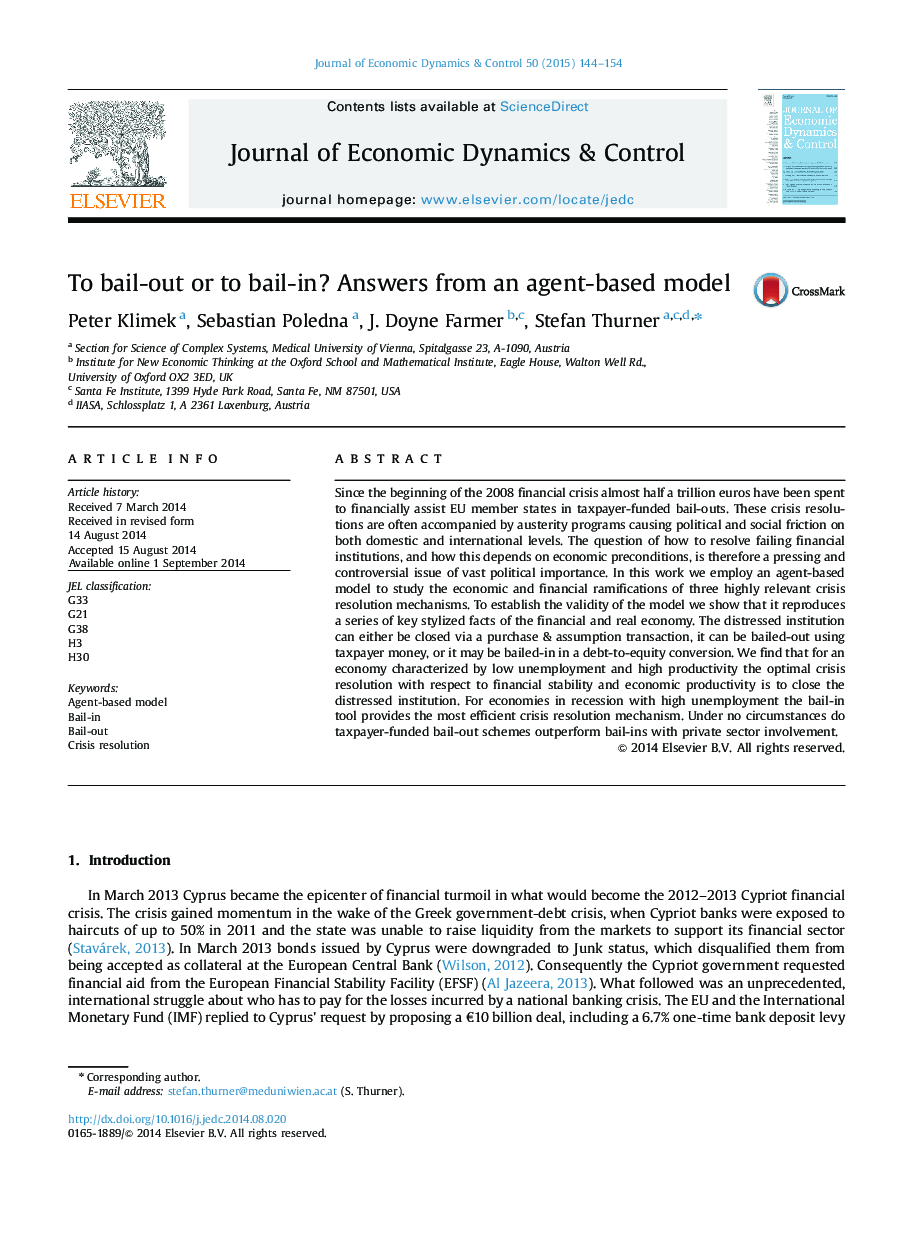| کد مقاله | کد نشریه | سال انتشار | مقاله انگلیسی | نسخه تمام متن |
|---|---|---|---|---|
| 5098384 | 1478695 | 2015 | 11 صفحه PDF | دانلود رایگان |
عنوان انگلیسی مقاله ISI
To bail-out or to bail-in? Answers from an agent-based model
ترجمه فارسی عنوان
برای امداد رسانی و یا به قید وثیقه؟ پاسخ از یک مدل مبتنی بر عامل
دانلود مقاله + سفارش ترجمه
دانلود مقاله ISI انگلیسی
رایگان برای ایرانیان
ترجمه چکیده
از آغاز بحران مالی سال 2008، تقریبا نیمی از تریلیون یورو برای کمک مالی به کشورهای عضو اتحادیه اروپا در پرداخت کمک مالی مالیات دهندگان صرف شده است. این قطعنامه های بحرانی اغلب همراه با برنامه های ریاضتی است که باعث اصطکاک سیاسی و اجتماعی در سطح داخلی و بین المللی می شود. بنابراین مسئله چگونگی حل نگرانی های مالی موسسات و این که این بستگی به پیش شرط های اقتصادی دارد، موضوع مهمی و بحث برانگیز اهمیت گسترده سیاسی است. در این کار، ما یک مدل مبتنی بر عامل را برای مطالعه تأثیرات اقتصادی و مالی سه سازوکار بسیار مهم مرتبط با بحران مورد استفاده قرار می دهیم. برای اثبات اعتبار مدل ما نشان می دهیم که مجموعه ای از واقعیت های کلیدی تلطیف شده اقتصاد مالی و واقعی را بازتولید می کند. موسسه مضطرب میتواند از طریق معامله خرید و پیشنهادی بسته شود، میتواند با استفاده از پول مالیات دهندگان، یا از طریق پرداخت بدهی به حق تبدیل شود. ما دریافتیم که برای اقتصاد مشخص شده با بیکاری پایین و بهره وری بالا، حل بحران بهینه با توجه به ثبات مالی و بهره وری اقتصادی بستن موسسه مضطرب است. برای اقتصادهایی که در رکود اقتصادی با بیکاری بالا هستند، ابزار بلاعزمانی مؤثرترین مکانیزم حل بحران را فراهم می کند. در هیچ شرایطی، طرح های امداد مالی مالیات دهندگان با تعهدات بخش خصوصی فراتر نمی روند.
موضوعات مرتبط
مهندسی و علوم پایه
ریاضیات
کنترل و بهینه سازی
چکیده انگلیسی
Since the beginning of the 2008 financial crisis almost half a trillion euros have been spent to financially assist EU member states in taxpayer-funded bail-outs. These crisis resolutions are often accompanied by austerity programs causing political and social friction on both domestic and international levels. The question of how to resolve failing financial institutions, and how this depends on economic preconditions, is therefore a pressing and controversial issue of vast political importance. In this work we employ an agent-based model to study the economic and financial ramifications of three highly relevant crisis resolution mechanisms. To establish the validity of the model we show that it reproduces a series of key stylized facts of the financial and real economy. The distressed institution can either be closed via a purchase & assumption transaction, it can be bailed-out using taxpayer money, or it may be bailed-in in a debt-to-equity conversion. We find that for an economy characterized by low unemployment and high productivity the optimal crisis resolution with respect to financial stability and economic productivity is to close the distressed institution. For economies in recession with high unemployment the bail-in tool provides the most efficient crisis resolution mechanism. Under no circumstances do taxpayer-funded bail-out schemes outperform bail-ins with private sector involvement.
ناشر
Database: Elsevier - ScienceDirect (ساینس دایرکت)
Journal: Journal of Economic Dynamics and Control - Volume 50, January 2015, Pages 144-154
Journal: Journal of Economic Dynamics and Control - Volume 50, January 2015, Pages 144-154
نویسندگان
Peter Klimek, Sebastian Poledna, J. Doyne Farmer, Stefan Thurner,
